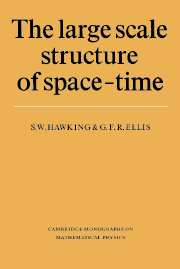Book contents
- Frontmatter
- Contents
- Preface
- 1 The role of gravity
- 2 Differential geometry
- 3 General Relativity
- 4 The physical significance of curvature
- 5 Exact solutions
- 6 Causal structure
- 7 The Cauchy problem in General Relativity
- 8 Space–time singularities
- 9 Gravitational collapse and black holes
- 10 The initial singularity in the universe
- Appendix A Translation of an essay by P. S. Laplace
- Appendix B Spherically symmetric solutions and Birkhoff's theorem
- References
- Notation
- Index
10 - The initial singularity in the universe
Published online by Cambridge University Press: 26 January 2010
- Frontmatter
- Contents
- Preface
- 1 The role of gravity
- 2 Differential geometry
- 3 General Relativity
- 4 The physical significance of curvature
- 5 Exact solutions
- 6 Causal structure
- 7 The Cauchy problem in General Relativity
- 8 Space–time singularities
- 9 Gravitational collapse and black holes
- 10 The initial singularity in the universe
- Appendix A Translation of an essay by P. S. Laplace
- Appendix B Spherically symmetric solutions and Birkhoff's theorem
- References
- Notation
- Index
Summary
The expansion of the universe is in many ways similar to the collapse of a star, except that the sense of time is reversed. We shall show in this chapter that the conditions of theorems 2 and 3 seem to be satisfied, indicating that there was a singularity at the beginning of the present expansion phase of the universe, and we discuss the implications of space–time singularities.
In §10.1 we show that past-directed closed trapped surfaces exist if the microwave background radiation in the universe has been partially thermalized by scattering, or alternatively if the Copernican assumption holds, i.e. we do not occupy a special position in the universe. In §10.2 we discuss the possible nature of the singularity and the breakdown of physical theory which occurs there.
The expansion of the universe
In §9.1 we showed that many stars would eventually collapse and produce closed trapped surfaces. If one goes to a larger scale, one can view the expansion of the universe as the time reverse of a collapse. Thus one might expect that the conditions of theorem 2 would be satisfied in the reverse direction of time on a cosmological scale, providing that the universe is in some sense sufficiently symmetrical, and contains a sufficient amount of matter to give rise to closed trapped surfaces. We shall give two arguments to show that this indeed seems to be the case. Both arguments are based on the observations of the microwave background, but the assumptions made are rather different.
Information
- Type
- Chapter
- Information
- The Large Scale Structure of Space-Time , pp. 348 - 364Publisher: Cambridge University PressPrint publication year: 1973
